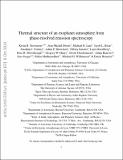| dc.contributor.author | Stevenson, K. B. | |
| dc.contributor.author | Desert, J.-M. | |
| dc.contributor.author | Line, Michael R. | |
| dc.contributor.author | Bean, J. L. | |
| dc.contributor.author | Fortney, Jonathan J. | |
| dc.contributor.author | Showman, A. P. | |
| dc.contributor.author | Kataria, T. | |
| dc.contributor.author | Kreidberg, Laura | |
| dc.contributor.author | McCullough, Peter R. | |
| dc.contributor.author | Henry, Gregory W. | |
| dc.contributor.author | Charbonneau, D. | |
| dc.contributor.author | Burrows, A. | |
| dc.contributor.author | Madhusudhan, Nikku | |
| dc.contributor.author | Williamson, M. H. | |
| dc.contributor.author | Homeier, Derek | |
| dc.contributor.author | Seager, Sara | |
| dc.date.accessioned | 2015-07-29T12:11:19Z | |
| dc.date.available | 2015-07-29T12:11:19Z | |
| dc.date.issued | 2014-10 | |
| dc.date.submitted | 2014-05 | |
| dc.identifier.issn | 0036-8075 | |
| dc.identifier.issn | 1095-9203 | |
| dc.identifier.uri | http://hdl.handle.net/1721.1/97911 | |
| dc.description.abstract | Exoplanets that orbit close to their host stars are much more highly irradiated than their solar system counterparts. Understanding the thermal structures and appearances of these planets requires investigating how their atmospheres respond to such extreme stellar forcing. We present spectroscopic thermal emission measurements as a function of orbital phase (“phase-curve observations”) for the highly irradiated exoplanet WASP-43b spanning three full planet rotations using the Hubble Space Telescope. With these data, we construct a map of the planet’s atmospheric thermal structure, from which we find large day-night temperature variations at all measured altitudes and a monotonically decreasing temperature with pressure at all longitudes. We also derive a Bond albedo of 0.18[+0.07 over -0.12] and an altitude dependence in the hot-spot offset relative to the substellar point. | en_US |
| dc.description.sponsorship | Massachusetts Institute of Technology | en_US |
| dc.language.iso | en_US | |
| dc.publisher | American Association for the Advancement of Science (AAAS) | en_US |
| dc.relation.isversionof | http://dx.doi.org/10.1126/science.1256758 | en_US |
| dc.rights | Article is made available in accordance with the publisher's policy and may be subject to US copyright law. Please refer to the publisher's site for terms of use. | en_US |
| dc.source | arXiv | en_US |
| dc.title | Thermal structure of an exoplanet atmosphere from phase-resolved emission spectroscopy | en_US |
| dc.type | Article | en_US |
| dc.identifier.citation | Stevenson, K. B., J.-M. Desert, M. R. Line, J. L. Bean, J. J. Fortney, A. P. Showman, T. Kataria, et al. “Thermal Structure of an Exoplanet Atmosphere from Phase-Resolved Emission Spectroscopy.” Science 346, no. 6211 (October 9, 2014): 838–841. | en_US |
| dc.contributor.department | Massachusetts Institute of Technology. Department of Earth, Atmospheric, and Planetary Sciences | en_US |
| dc.contributor.department | Massachusetts Institute of Technology. Department of Physics | en_US |
| dc.contributor.mitauthor | Seager, Sara | en_US |
| dc.relation.journal | Science | en_US |
| dc.eprint.version | Author's final manuscript | en_US |
| dc.type.uri | http://purl.org/eprint/type/JournalArticle | en_US |
| eprint.status | http://purl.org/eprint/status/PeerReviewed | en_US |
| dspace.orderedauthors | Stevenson, K. B.; Desert, J.-M.; Line, M. R.; Bean, J. L.; Fortney, J. J.; Showman, A. P.; Kataria, T.; Kreidberg, L.; McCullough, P. R.; Henry, G. W.; Charbonneau, D.; Burrows, A.; Seager, S.; Madhusudhan, N.; Williamson, M. H.; Homeier, D. | en_US |
| dc.identifier.orcid | https://orcid.org/0000-0002-6892-6948 | |
| mit.license | PUBLISHER_POLICY | en_US |
| mit.metadata.status | Complete | |
